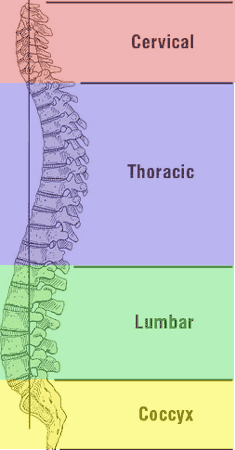I found these a few weeks ago and find them useful. I come back to them throughout the day.
W
Ryan Lee, MS, CSCS
Good posture is simply the ability to maintain the normal spinal curves. Further to this, dynamic postural stability is the concept of maintaining a desired alignment (such as the spinal angle) against external forces and loads
Normal Spinal Curves exist to increase the flexibility of movement, enhance shock-absorbing capacity, and ensure adequate stiffness and stability at each joint.

Neck/Cervical spine = subtle inward curve
Mid-back/Thoracic spine = subtle outward curve
Low back/Lumbar spine= subtle inward curve
Sacrum(Coccyx) = subtle outward angle
The first step towards improving your posture is to first become aware of it. Poor posture doesn't happen overnight, it is a function of poor habits in all activities day in and day out.
To help increase your postural awareness try these simple exercises throughout your day, everyday:
1 Neck Check - Place your two fingers at the base of your skull. Run the fingers along your cervical spine. Do you feel any divots? If yes, place your fingers back in the divot. Imagine a string tied to the back of your head. This string is being GENTLY lifted to the ceiling, gradually lengthening your neck along the way (your chin will nod in slightly). Stop lengthening as soon as you feel the divot disappear. Hold this position for as long as possible.

2 Shoulder Check - Many of us carry the stresses of our day in our shoulder area. Where are your shoulders sitting right now? Are they up around your ears? RELAX. Drop the shoulders down, away from your ears. Hold this position for as long as you can as you go about your way. Recheck often.
3 Breastbone Check - To bring your shoulders in line with your ears try this simple posture cue. Instead of shrugging your shoulders back in the classic military pose, simply lift your breastbone slightly & gently to the sky or ceiling. This will open up your chest, drop your shoulders back and gently improve your alignment. Hold for as long as you can. Recheck often.
4 Abdominal Tuck - To help begin increasing your core stability protect your lumbar spine, consciously engage your core muscles (transverse abs and anterior pelvic floor in particular). This can be done by gradually and gently drawing your lower abdomen in toward your spine/pelvis. Place your fingers on the front points of your hips. Inhale wide into your ribcage & back (think of flaring both).

These simple posture cues, if practiced daily, will not only help improve your posture to positively impact your golf swing but for all your activities be they work, home or play. However, practicing these cues are not enough. In order to have great dynamic postural stability you need to train the muscles that act as the support wires for the spine.
Good posture is simply the ability to maintain the normal spinal curves. Further to this, dynamic postural stability is the concept of maintaining a desired alignment (such as the spinal angle) against external forces and loads
Normal Spinal Curves exist to increase the flexibility of movement, enhance shock-absorbing capacity, and ensure adequate stiffness and stability at each joint.

Neck/Cervical spine = subtle inward curve
Mid-back/Thoracic spine = subtle outward curve
Low back/Lumbar spine= subtle inward curve
Sacrum(Coccyx) = subtle outward angle
The first step towards improving your posture is to first become aware of it. Poor posture doesn't happen overnight, it is a function of poor habits in all activities day in and day out.
To help increase your postural awareness try these simple exercises throughout your day, everyday:
1 Neck Check - Place your two fingers at the base of your skull. Run the fingers along your cervical spine. Do you feel any divots? If yes, place your fingers back in the divot. Imagine a string tied to the back of your head. This string is being GENTLY lifted to the ceiling, gradually lengthening your neck along the way (your chin will nod in slightly). Stop lengthening as soon as you feel the divot disappear. Hold this position for as long as possible.

2 Shoulder Check - Many of us carry the stresses of our day in our shoulder area. Where are your shoulders sitting right now? Are they up around your ears? RELAX. Drop the shoulders down, away from your ears. Hold this position for as long as you can as you go about your way. Recheck often.
3 Breastbone Check - To bring your shoulders in line with your ears try this simple posture cue. Instead of shrugging your shoulders back in the classic military pose, simply lift your breastbone slightly & gently to the sky or ceiling. This will open up your chest, drop your shoulders back and gently improve your alignment. Hold for as long as you can. Recheck often.
4 Abdominal Tuck - To help begin increasing your core stability protect your lumbar spine, consciously engage your core muscles (transverse abs and anterior pelvic floor in particular). This can be done by gradually and gently drawing your lower abdomen in toward your spine/pelvis. Place your fingers on the front points of your hips. Inhale wide into your ribcage & back (think of flaring both).

These simple posture cues, if practiced daily, will not only help improve your posture to positively impact your golf swing but for all your activities be they work, home or play. However, practicing these cues are not enough. In order to have great dynamic postural stability you need to train the muscles that act as the support wires for the spine.



Comment